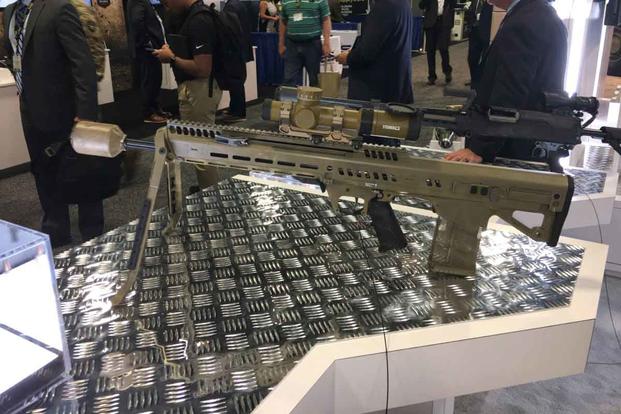The U.S. Army's Next Generation Squad Weapon effort looked a lot more possible this week as the three competing weapons firms displayed their prototype 6.8mm rifles and automatic rifles at the 2019 Association of the United States Army's annual meeting.
Just two months ago, the Army selected General Dynamics Ordnance and Tactical Systems inc., Textron Systems and Sig Sauer Inc. for the final phase of the NGSW effort -- one of the service's top modernization priorities to replace the 5.56mm M4A1 carbine and the M249 squad automatic weapon in infantry and other close-combat units.
Army officials, as well as the companies in competition, have been guarded about specific details, but the end result will equip combat squads with weapons that fire a specially designed 6.8mm projectile, capable of penetrating enemy body armor at ranges well beyond the current M855A1 556mm round.
There have previously been glimpses of weapons from two firms, but this year's AUSA was the first time all three competitors displayed their prototype weapons, which are distinctly different from one another.
Related: Check out Military.com's coverage of the AUSA Conference
"A lot of progress has been achieved just in the last 12 months since the previous AUSA," Brig. Gen. Dave Hodne, director of the Soldier Lethality Cross-Functional Team and chief of infantry at the Maneuver Center of Excellence at Fort Benning, Georgia, told an audience Tuesday at AUSA.
"In fact, there were some aspects of last year's AUSA where some would say what we are pursuing was unachievable, and I would tell you those impossibilities are on the floor here today," he said.
The Army plans to select a final design for both weapons from a single company in the first quarter of 2022 and begin fielding them to an infantry brigade combat team in the first quarter of 2023, modernization officials have said.
The General Dynamics Bullpup
The team from General Dynamics unveiled its bullpup-style NGSW rifle and AR prototypes -- a design which puts the magazine and bolt-carrier group behind the pistol grip and trigger group.
While popular in other parts of the world, the bullpup design has never really caught on in the U.S. as the military, as well as the civilian market, prefers the more traditional design in which the magazine well and bolt group are forward of the pistol grip.
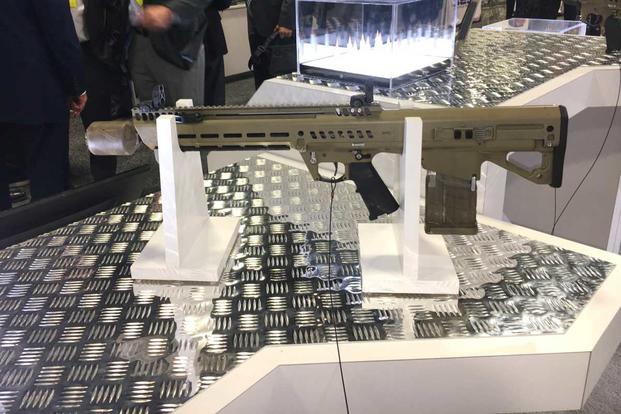
"The reason we ended up with a bullpup is because, when they are talking about all the stuff we are not supposed to talk about -- the velocities ... the effects downrange that are going to be required to push the projectiles -- we came back and said, 'What do we need?' We need barrel length," said Kevin Sims, senior director of Business Development at General Dynamics.
The rifle variant features a 20-inch barrel while the AR version has a 22-inch barrel, but both weapons are still very compact, he said, adding that the rifle is shorter than the M4A1 and the AR is shorter than the M249.
Fully extended, the 33-inch M4A1 has a 14.5-inch barrel, and the M249's 36-inch para version has a barrel length of just over 16 inches.
"I personally had concerns about the acceptance of the bullpup design, but I think that has been sort of eliminated with a lot of user feedback that we have received," Sims said. "People aren't worried about it. It's a very balanced rifle; it's not front-heavy."
Sims, like other competitors, kept some details vague, such as the weight, except to say the rifle is under 10 pounds and the AR is under 11 pounds, meeting the NGSW requirement.
"We continue to try and remove weight where we can, but we've got a big cartridge that we are plugging," he said.
General Dynamics has teamed with True Velocity to produce a composite-cased 6.8mm cartridge. For gun-making expertise, GD joined with Beretta USA, which made the U.S. Army's M9 pistol for decades before the Sig Sauer Modular Handgun System was chosen in 2017 to replace it.
All fire controls are ambidextrous. Like the rifle version, the AR is magazine-fed, said Sims, who added that the designers haven't decided on a rate of fire yet.
"We are going between 500 and 750 shots per minute on the AR and will make a determination on which one hits the sweet spot," he said.
GD has chosen Delta P Design to make the suppressors for both prototypes, which are made from a hardened Inconel alloy for extreme light weight, Sims said.
Textron's Case-Telescoped Weapons
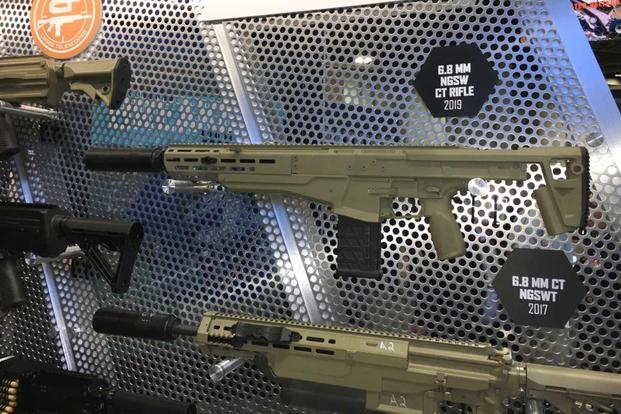
The belt-fed Textron Systems' NGSW AR variant and the magazine-fed rifle variant both rely on the company's case-telescoped cartridge design it developed
the U.S. Army's Lightweight Small Arms Technology program.
Textron has developed its CT technology in 5.56mm, 7.62mm, 6.5mm and now 6.8mm. The technology uses a plastic case rather than a brass case to hold the propellant and the projectile, resulting in a significant weight savings, Wayne Prender, senior vice president for Applied Technologies & Advanced Programs at Textron, told reporters at AUSA.
"I am really proud to showcase for you for the first time our Next Generation Squad Weapon technology offering," Prender said.
The team from Textron includes Heckler & Koch -- the maker of the Marine Corps' M27 infantry automatic rifle -- and Olin Winchester for its small-caliber ammunition production capabilities.
Prender would not discuss specific details about Textron's NGSW prototypes, such as the operating system, rate of fire or barrel lengths. The auto rifle weighs less than 12 pounds, and the more traditionally styled rifle weighs less than nine pounds, he said.

Like all competitor prototypes, Textron's weapons feature an intelligent rail that will power the Next Generation Fire Control system being developed under a separate Army effort. Textron's initial rifle prototype featured a large battery pack mounted beneath the weapon's handguard, Prender said.
The current rifle prototype has a much smaller battery pack mounted in the collapsible buttstock, he said.
Lewis Machine & Tool Company has been selected to make the suppressors for both weapon variants, Prender added.
Sig Sauer's Classic M4 Design
Sig Sauer's NGSW offerings look the most traditional out of all three competitors since Sig's rifle variant is an M4-style design.
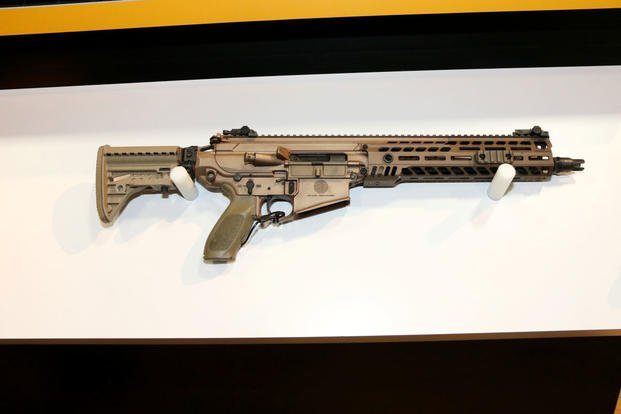
"It's what soldiers know; the innovation can be ... inside. That's what allows you to advance the weapon system, but soldiers ... are used to training with an M4-style weapon system," said Paul Snyder, product manager for belt-fed systems at Sig Sauer.
One unique feature on the rifle variant, known as the Spear, is that it boasts a side-charging handle located on the non-ejection port side of the weapon, so soldiers don't have to take their hand off the pistol grip to charge the weapon, he said.
Sig Sauer also left the traditional M4-style charging handle in place to give soldiers more options, Snyder said.
The rifle weighs under 10 pounds and features a 13-inch barrel "that gives us the velocity we need to hit the requirement," he said. It features a two-position gas setting for suppressed and unsuppressed firing.
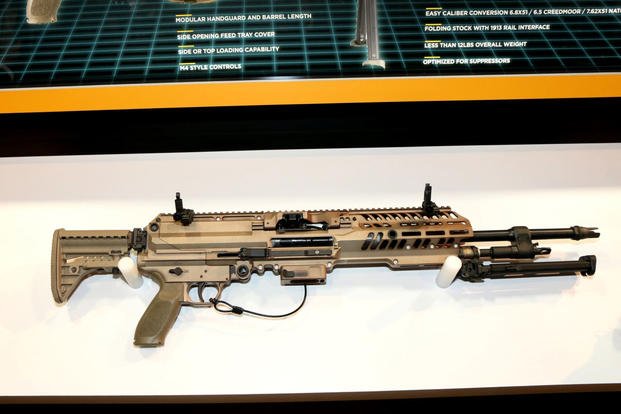
The AR variant, known as the MG 6.8mm, weighs under 12 pounds, features a 16-inch barrel and has a rate of fire of 600 rounds per minute, Snyder said.
One of the most interesting features of Sig's AR is a compact feed tray that lifts up toward the ejection-side of the weapon, instead of traditional feed trays that are usually longer and lift up toward the muzzle of the weapon.
The feature saves rail space and gives operators more options to mount accessories, Snyder said.
While it's belt-fed, the AR still has a magazine well that the 50- and 100-round ammo-belt bags insert into, he said.
"Also, we can load with the cover down; there is no need to lift the tray," Snyder said. "Typically, if you are in an engagement, you have to lift the cover, sweep the links out of the way, check tray and then load and shoot.
"For us we keep control of the last link."
The gunner drops the belt-bag magazine, inserts a new one and jams the belt in -- which pushes the last link out and the weapon is ready to fire, Snyder said.
The AR is also capable of quick-barrel changes to prevent overheating, he said. And like the rifle version, the AR has a two-position setting for suppressed and unsuppressed firing.
Snyder pointed out that Sig Sauer -- the maker of the Army's new Modular Handgun System -- is the only competitor that is doing all of the work in-house.
"Everything on the table today is Sig," he said. "We are the only ones that haven't partnered up with anyone. This is all Sig -- Sig guns, Sig suppressor, Sig ammo, Sig accessories."
-- Matthew Cox can be reached at matthew.cox@military.com.
Read more: New Army Chief Wants to Let Soldiers Stay Longer at Favorite Duty Stations
